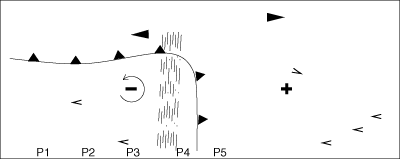Figure 2: (
a). Phase-intensity observations over Veluwe Lake, the Netherlands. The colored section shows interferometric phase observations, converted to slant signal delay variations in mm. The gray-scale part of the figure is derived from the backscatter intensity during the ERS-2 acquisition, and is scaled to logarithmic

values. The band with increased delay indicates strong rain, and is clearly correlated to the increased surface roughness over the water. (
b) Cross section AA' of the radar cross section values in panel (
a) The

values increase approximately 18 dB due to wind patterns associated with the storm. Behind the first rain band, indicated by label P4, roughness decreases and increases again, as observed in the first 6 km of the cross section. (
c) Sketch of the circulation patterns associated with the cold front, after
Parsons [1992]. The vertical shear in front of the storm consists of a windless area at the surface and probably a southwesterly wind aloft.




